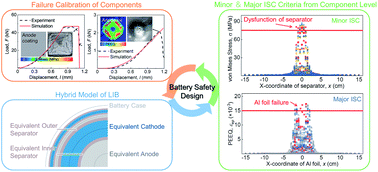Criteria and design guidance for lithium-ion battery safety from a material perspective
Abstract
With the rapid development of electric vehicles (EVs) and electronic devices in current mobile society, the safety issues of lithium-ion batteries (LIBs) have attracted worldwide attention. Mechanical, electrochemical, and thermal abusive loading are three leading factors that trigger the safety issues of batteries. The ultimate direct reason for the internal short circuit (ISC) is the contact of conductive materials driven by mechanical stress/deformations. However, a complete set of mechanics-based criteria for ISCs in the battery component material level is still lacking. Herein, we first calibrate the mechanical behaviors of the battery component materials individually in representative mechanical loading conditions. Both minor and major ISCs are identified, and the corresponding criteria are proposed based on the mechanical status of each component material by leveraging the numerical simulation and stacking tests. To further validate our criteria, we compare the numerical prediction with experiments and obtain a satisfactory agreement. Finally, through a systematic parametric study of the design variables, we discover that proper selection and tuning of the mechanical properties and thickness for the coating and the current collector can significantly mitigate and postpone the major ISC. The results provide critical insights to understand the fundamental mechanistic behaviors during ISCs and offer design guidance for next-generation safe batteries.

- This article is part of the themed collection: Electric vehicles and batteries


 Please wait while we load your content...
Please wait while we load your content...